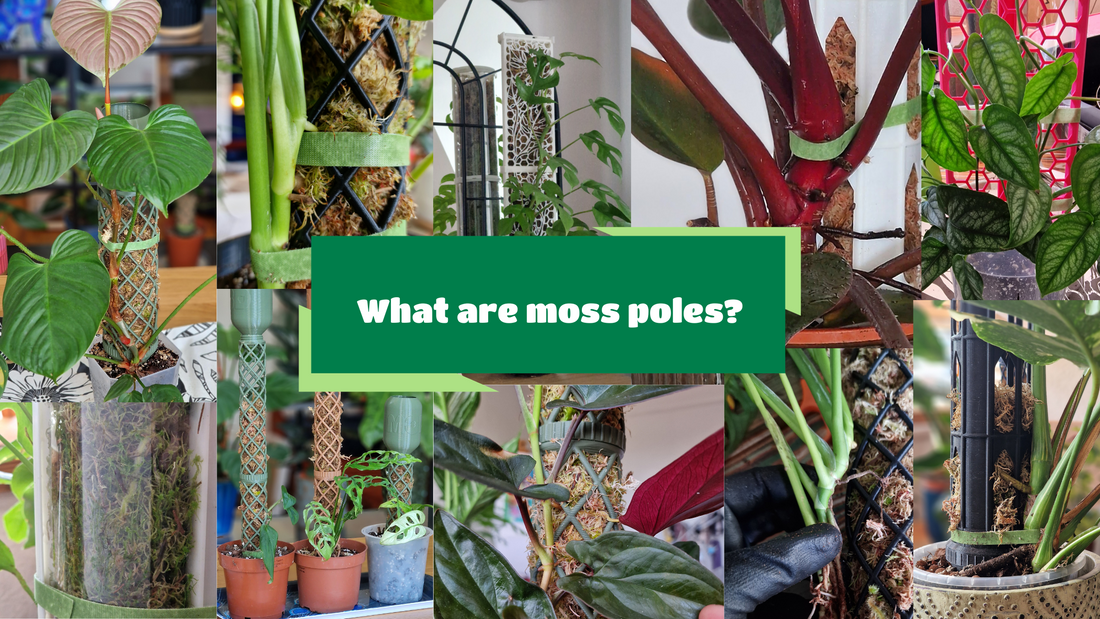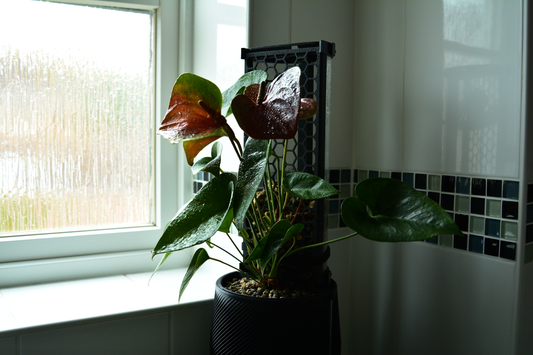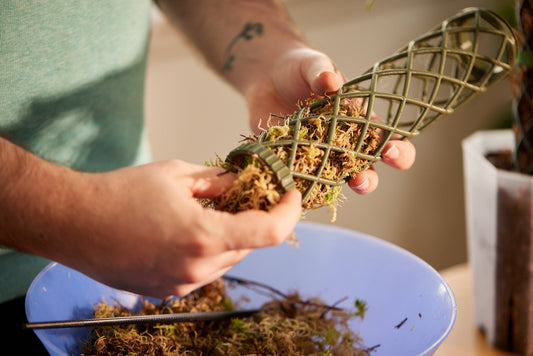
What are moss poles exactly? Moss poles explained.
Share
The million dollar question we get when we talk about our moss pole business is: what on earth is a moss pole?!
The summed up answer is that a moss pole is an indoor gardening aid for plants of the climbing variety. Moss poles provide support, moisture control, growth direction, and a whole slew of other benefits (more of those here). We will discuss more in depth what makes up a moss pole in this blog post.
Moss pole structure and material
As you might know, there are many different kinds of moss poles out there, and there is some argument as to what exactly constitutes a moss pole. However, I think most would agree that a moss pole must provide a plant with vertical support, along with some sort of surface to which it may attach its aerial roots. We are of the opinion that if no actual moss is used, there are more appropriate terms such as "coir pole" or "trellis" that should be used instead! But ultimately, what matters most is being understood.
This generally means that the moss pole consists of two or more basic materials.
Moss pole core material, a.k.a "the structure": Moss poles are typically constructed using a sturdy core material such as PVC pipe, bamboo, wire, 3D printed plastic (we use PLA+, a Bioplastic), or wood. This rigid core provides structural support for the pole.
Contact material, a.k.a "the moss": The core is then covered or filled with the material that the aerial roots will come in contact with. This could be sphagnum moss, hemp fibre, bark, coco coir, or some other organic material. The material should help retain moisture and provide a suitable surface and environment for aerial roots to anchor and grow. We choose to fill our moss poles with Sphagnum moss for its many benefits (extreme saturation level, high nutrient content, and antibacterial properties). Cage-type moss poles such as ours can also be filled with chunky substrates like bark or Perlite, and even LECA, to provide the environment you feel will benefit your plant the most.

These two elements, the rigid support structure, and the material that fills or surrounds the pole, constitute a moss pole.
If you'd like a challenge, you can create your own moss pole using a fine steel mesh (chicken fencing or similar) and wire or zip ties. There are loads of tutorials on YouTube!
On the readymade side, coco coir poles have become popular to the point that searching for moss poles on Google will display these almost exclusively; be aware that they don't hold moisture for very long, and provide limited benefits.
Why do people use moss poles?
So, what are they for?
Support
Moss poles are used to support climbing plants from genus like Monstera, Philodendron, Pothos, etc., along with various other tropical plants with vining or aerial growth habits. Many of the typical indoor plants that you find in plant shops and supermarkets will climb a moss pole. These plants are often sold as trailing or hanging plants, and these vining plants will indeed look fantastic flowing down a bookcase or the like! It all depends on what your style and gardening goals are.
But if given the chance, these plants will quickly take the support offered by a moss pole and grow up towards the light, mimicking their behaviour in nature. This will lead to a larger root system (all the aerial roots will develop if given a environment to grow into), and the result will be a more mature and developed plant with larger leaves and more stable fenestrations.
Here is where the support comes in, as mature big leaves can become quite heavy, so the stability of the moss pole becomes essential.

Aerial roots and growth
Many climbing plants have aerial roots that they use to attach themselves to surfaces for support. The organic material of the moss or coir covering on the pole provides a suitable medium for the development of these roots, particularly if they can absorb moisture and nutrients from this substrate (again, the reason we use Sphagnum moss). Aerial roots grow into the moss or coir, helping the plant anchor itself to the pole, and developing what can be massive root systems.
Hydration and humidity
Aside from providing hydration to the embedded aerial roots, the moisture retaining sphagnum moss or coco coir covering on the moss pole will slowly evaporate, creating a humid microenvironment around the plant. This can be beneficial for plants that thrive in high humidity conditions, such as many tropical and epiphytic species. Obviously sphagnum moss holds moisture a lot better than just about any other natural substrate, it can absorb up to 20 times it's weight in water!
Aesthetics
Moss poles can also serve as decorative elements in indoor gardens. The natural look of moss or coir can enhance the overall aesthetic of the plant display. Some moss poles are designed to be visually appealing (hint hint), adding to the overall decor of the space.
In setups where space is a factor, a vertical garden element can be the only solution for displaying large leaf exotic beauties.

How to install a moss pole
The exact process will depend on your particular moss pole. Sometimes beginner plants are sold with moss poles attached, other times you will have to pot them up yourself. The best way to introduce a new moss pole is to make it part of the potting up process.
As one of the key targets of a moss pole is to provide support, you will want to ensure the pole is as stable as possible.
Our moss poles are typically partially buried into the potting soil, sometimes even attached to the nursery pot, and they stand up from the planter. We have a stake or base bottom attachment depending on whether the moss pole is being added during a repot (most stable), or as an upgrade to an established plant. As the plant starts to grow, its vines or stems can be secured to the pole using ties or plant clips, just until it gets purchase into the contact medium.
In summary, moss poles provide structural support, encourage aerial root growth, retain moisture, and enhance the aesthetic appeal of climbing plants. They are a practical and visually pleasing solution for indoor plant enthusiasts and can help you both upgrade and tame your houseplant jungle!



